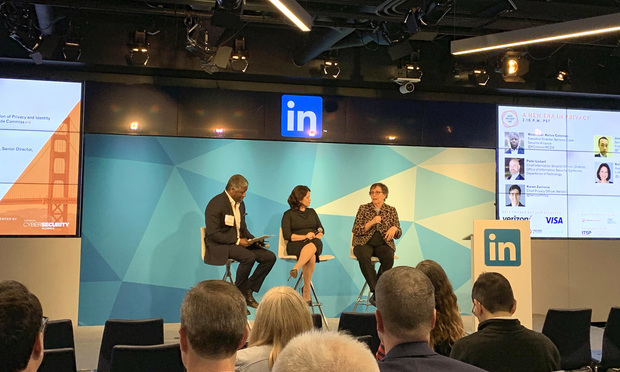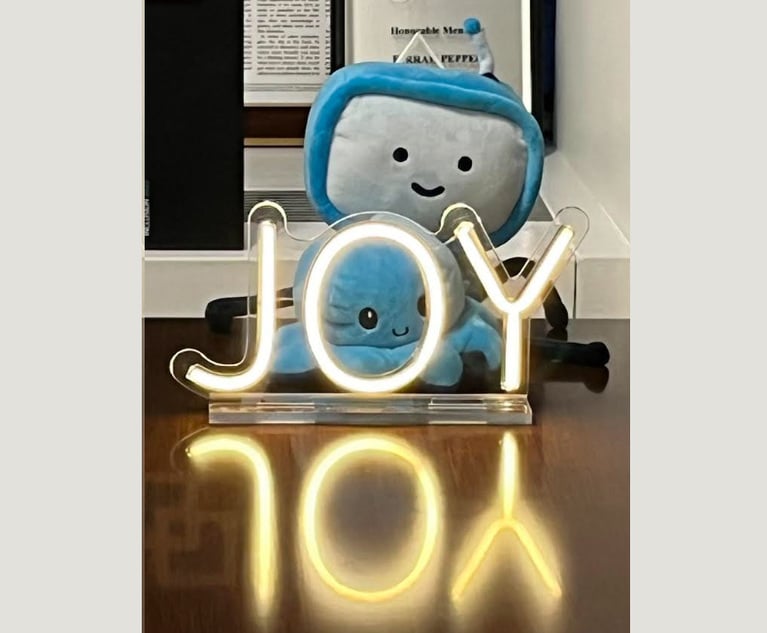5 Ways to Increase Data Privacy Efforts, According to Top Chief Privacy Officers
Chief privacy officers from Visa, Microsoft and other large companies shared their advice and predictions for the future of data privacy at an event Monday.
January 29, 2019 at 03:55 PM
4 minute read
 L-R: Kelvin Coleman, executive director with NCSA, Kalinda Raina, head of global policy with LinkedIn and Karen Zacharia, chief privacy officer with Verizon at LinkedIn's headquarters, in San Francisco. Photo: Caroline Spiezio/ALM.
L-R: Kelvin Coleman, executive director with NCSA, Kalinda Raina, head of global policy with LinkedIn and Karen Zacharia, chief privacy officer with Verizon at LinkedIn's headquarters, in San Francisco. Photo: Caroline Spiezio/ALM.
Executives from Microsoft Corp., Verizon Wireless, Visa Inc. and others gathered at LinkedIn's San Francisco headquarters Monday for a series of panels on data privacy.
As part of Data Privacy Day, chief privacy officers discussed their companies' struggles and successes in a changing regulatory landscape. They also shared their observations and advice on developing a strong data privacy program. Here's a roundup of their tips for in-house counsel.
1. Implement privacy by design
Including privacy concepts at a project's beginning can help prevent last-minute security issues that delay or shut down launches, panelists said.
"Thinking about what you're doing with data from the first time you're collecting it, to how you're designing a product to the user interface, so that what data you're collecting and how you're using it is made as transparent as possible," said John Gevertz, the chief privacy officer of Visa.
2. Send the message from the top down
Company leaders should set the tone for privacy and ensure the concept of privacy by design is spread to all layers of an organization.
"You really need to start at the top and have that come down, because that is where priorities get set," said Brendon Lynch, Microsoft's chief privacy officer. "For example … we have a regular meeting with the CEO and the leadership team to report where we're going, how on track we are, where we need additional resources, that kind of thing. And that permeates right through the organization. People know privacy is a priority."
3. Make data privacy information accessible
Privacy counsel should keep data policies transparent, allowing users to know what data is being collected and how it's being used. But it's also important to keep the message as simple and short as possible, so people read and understand the whole thing, Verizon chief privacy officer Karen Zacharia said.
"I often say that one of the hardest things that we do is say something doesn't have to go in a notice. And that's not because I'm saying we should hide something. It's perhaps because it's so obvious that we shouldn't be clogging up, putting additional words into the notice about something that consumers really understand," Zacharia said. "Or perhaps it's less important than the really big thing we think is most important to consumers. Getting that balance right really is a challenge for all of us."
4. Include non-lawyers in the process
Many privacy teams are led by lawyers, but Kalinda Raina, the head of global privacy at LinkedIn, said it's important to get input from other team members as well.
"I have a lot of folks on my team who are not lawyers. We work with our communications team, our design team. Because sometimes you have to get the lawyers out of the way, because we say a little too much that is hard to follow," Raina said. "So sometimes we work with other members of the team to figure out, 'How do we say this in a way people will engage with and understand?'"
5. Build trust with consumers
Stronger privacy regulations could help consumers trust new technology more, according to Lynch.
"Advocate for strong rules to be in place … a regulatory floor, whether it's baseline privacy legislation or regulating the misuses of facial recognition, that type of thing could actually be beneficial into building trust into the broad ecosystem and enabling people to embark on using these technologies," Lynch said.
Read More:
Google's GDPR Fine Is a Warning for Tech Company GCs: Double Check Data Consent Policies
This content has been archived. It is available through our partners, LexisNexis® and Bloomberg Law.
To view this content, please continue to their sites.
Not a Lexis Subscriber?
Subscribe Now
Not a Bloomberg Law Subscriber?
Subscribe Now
NOT FOR REPRINT
© 2025 ALM Global, LLC, All Rights Reserved. Request academic re-use from www.copyright.com. All other uses, submit a request to [email protected]. For more information visit Asset & Logo Licensing.
You Might Like
View All
How Marsh McLennan's Small But Mighty Legal Innovation Team Builds Solutions That Bring Joy

Aggressive FTC May Force Merging Companies to Bolster Legal Defenses
4 minute read
Best Legal Departments: How Blackstone's Legal and Compliance Team Got the All-Clear to Grow Business

CEOs Want Data-Based Risk Management; GCs Lack the Tech to Do So.
Trending Stories
- 1Uber Files RICO Suit Against Plaintiff-Side Firms Alleging Fraudulent Injury Claims
- 2The Law Firm Disrupted: Scrutinizing the Elephant More Than the Mouse
- 3Inherent Diminished Value Damages Unavailable to 3rd-Party Claimants, Court Says
- 4Pa. Defense Firm Sued by Client Over Ex-Eagles Player's $43.5M Med Mal Win
- 5Losses Mount at Morris Manning, but Departing Ex-Chair Stays Bullish About His Old Firm's Future
Who Got The Work
J. Brugh Lower of Gibbons has entered an appearance for industrial equipment supplier Devco Corporation in a pending trademark infringement lawsuit. The suit, accusing the defendant of selling knock-off Graco products, was filed Dec. 18 in New Jersey District Court by Rivkin Radler on behalf of Graco Inc. and Graco Minnesota. The case, assigned to U.S. District Judge Zahid N. Quraishi, is 3:24-cv-11294, Graco Inc. et al v. Devco Corporation.
Who Got The Work
Rebecca Maller-Stein and Kent A. Yalowitz of Arnold & Porter Kaye Scholer have entered their appearances for Hanaco Venture Capital and its executives, Lior Prosor and David Frankel, in a pending securities lawsuit. The action, filed on Dec. 24 in New York Southern District Court by Zell, Aron & Co. on behalf of Goldeneye Advisors, accuses the defendants of negligently and fraudulently managing the plaintiff's $1 million investment. The case, assigned to U.S. District Judge Vernon S. Broderick, is 1:24-cv-09918, Goldeneye Advisors, LLC v. Hanaco Venture Capital, Ltd. et al.
Who Got The Work
Attorneys from A&O Shearman has stepped in as defense counsel for Toronto-Dominion Bank and other defendants in a pending securities class action. The suit, filed Dec. 11 in New York Southern District Court by Bleichmar Fonti & Auld, accuses the defendants of concealing the bank's 'pervasive' deficiencies in regards to its compliance with the Bank Secrecy Act and the quality of its anti-money laundering controls. The case, assigned to U.S. District Judge Arun Subramanian, is 1:24-cv-09445, Gonzalez v. The Toronto-Dominion Bank et al.
Who Got The Work
Crown Castle International, a Pennsylvania company providing shared communications infrastructure, has turned to Luke D. Wolf of Gordon Rees Scully Mansukhani to fend off a pending breach-of-contract lawsuit. The court action, filed Nov. 25 in Michigan Eastern District Court by Hooper Hathaway PC on behalf of The Town Residences LLC, accuses Crown Castle of failing to transfer approximately $30,000 in utility payments from T-Mobile in breach of a roof-top lease and assignment agreement. The case, assigned to U.S. District Judge Susan K. Declercq, is 2:24-cv-13131, The Town Residences LLC v. T-Mobile US, Inc. et al.
Who Got The Work
Wilfred P. Coronato and Daniel M. Schwartz of McCarter & English have stepped in as defense counsel to Electrolux Home Products Inc. in a pending product liability lawsuit. The court action, filed Nov. 26 in New York Eastern District Court by Poulos Lopiccolo PC and Nagel Rice LLP on behalf of David Stern, alleges that the defendant's refrigerators’ drawers and shelving repeatedly break and fall apart within months after purchase. The case, assigned to U.S. District Judge Joan M. Azrack, is 2:24-cv-08204, Stern v. Electrolux Home Products, Inc.
Featured Firms
Law Offices of Gary Martin Hays & Associates, P.C.
(470) 294-1674
Law Offices of Mark E. Salomone
(857) 444-6468
Smith & Hassler
(713) 739-1250






